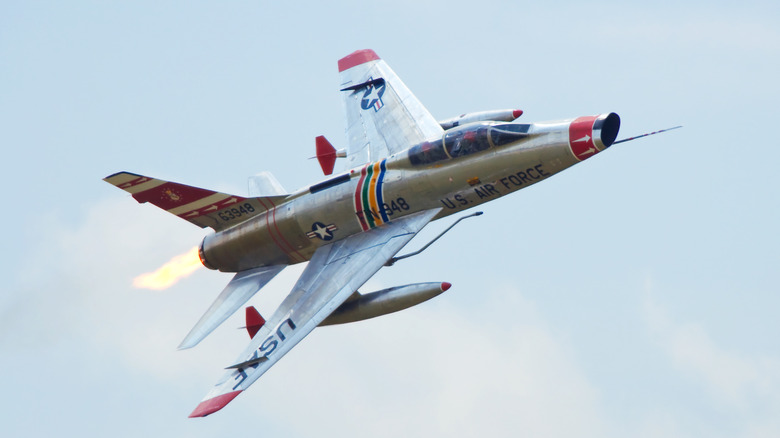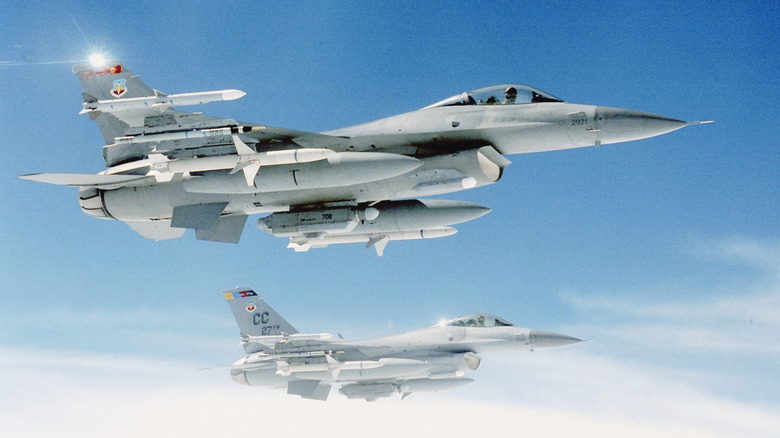
Darren Brode/Shutterstock
Aircraft are everywhere in our world, from commercial craft to those intended to quickly move those in need of medical attention. Of course, there are also those created for use by militaries around the world, and within this broad category, numerous smaller subsections exist. Some military craft are meant for reconnaissance, others to move troops and equipment, and loads of fighter jets — including some of the strangest ever seen — to duke it out with enemy craft in the skies. Often overlooked among their more mainstream contemporaries are jets that fall under the Wild Weasel moniker.
Advertisement
The origin of Wild Weasel jets goes back to the Vietnam War era, appropriately at the core of the United States Air Force’s Project Wild Weasel. The Soviet Union had established SA-2 surface-to-air missiles in North Vietnam, intended to take out American aircraft from the ground. As the 1950s came to an end and the 1960s began, the U.S. had no strong means of countering them, and time was of the essence. Eventually, F-100F jets were modified to accommodate a pilot who flew the jet and fired weaponry as an electronic warfare officer monitored enemy radar. This setup, dubbed the Wild Weasel I, proved effective at combatting SAMs, so the codename stuck around. Their mandate has endured well into the modern era, and the Air Force’s Wild Weasels have cemented their legacy as one of the military branch’s most important elements.
Advertisement
The need for Wild Weasels

Stocktrek/Getty Images
Wild Weasel missions aren’t for the faint of heart, and even though the jets responsible for them are remarkable, they’re still risky. They require Wild Weasels to fly into enemy territory ahead of strike forces to destroy, in the case of the Vietnam War, SAMs, but more broadly, any form of enemy weapon and radar that could take out incoming jets. Best case scenario: they destroy all of their weaponry and radar targets on their initial pass or, at the very least, intimidate the enemy into backing down. Regardless, they stick around as support for the strike force until their mission is complete.
Advertisement
It’s no stretch to say that Wild Weasels proved crucial to any Suppression of Enemy Air Defenses, or SEAD, Air Force operation. Without them, strike forces in war zones would have to contend not only with enemies in the air but those on the ground, which are more difficult to combat. They save lives, all while very much risking their own. During the Vietnam War, it wasn’t uncommon for Wild Weasels to act as bait for SAMs, goading them into firing and revealing their location so they could be more easily spotted and destroyed. All in all, 34 Wild Weasels were lost during the war, with 19 pilots becoming prisoners of war.
Despite the dangers, pilots throughout multiple decades have taken on the Wild Weasel name. They’ve put their lives on the line to protect their fellow pilots and countrymen, doing so in several different aircraft.
Advertisement
Which jets have taken on the Wild Weasel role?
As mentioned before, the F-100F served as the basis for the earliest Wild Weasel jets. While it did well enough at its job, as is the norm with military and aviation technology, innovation came along to render it obsolete. Not long after their first deployment in 1965, in 1966, the Wild Weasel I was replaced by the Wild Weasel III. This incarnation of the Wild Weasel used the F-105 as a base. You might be wondering why it isn’t designated as the Wild Weasel II. Simply put, the Wild Weasel II never made it to production.
Advertisement
Though it took many years to become a Wild Weasel, with work on making it so dating back to 1966, the F-4C became the Wild Weasel IV and took to the battlefront in the 1970s. The Wild Weasel V — an F-4 Phantom II variant known as the F-4G — followed suit, being introduced in 1975. The jet was ultimately retired in 1996, which marked the end of an era. This was the final craft in the Wild Weasel lineage specifically intended to take on SEAD missions. Now, its responsibilities are handled by Lockheed Martin’s American-made F-16 Fighting Falcon, though it will soon be replaced with the F-35A Lightning II.
The Wild Weasels were some of the most notable aircraft to fly during the Vietnam War and, arguably, some of the most important jets in United States Air Force history. Seeing as their position within the branch endures, it’s fair to say their impact is still felt in the modern day.
Advertisement
[Featured image by USAF via Wikimedia Commons | Cropped and scaled | CC0 1.0]















